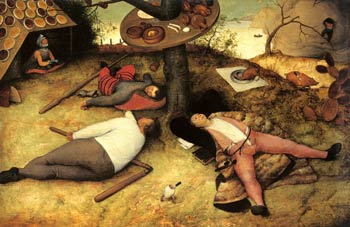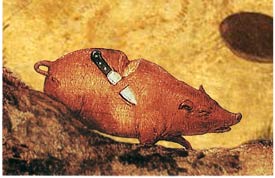Flemish, (c. 1525-1569)

-
The Land of Cockaigne
- (1567), oil on panel
- 20.5 x 30.7 in. (52 x 78 cm.)
- Alte Pinakothek, Munich
-
Editor’s Note:
The land of Cockaigne (or Cockayne) was a medieval fictional utopia. The most pervasive collective dream of medieval times, this imaginary land was an believed to be an earthly paradise where idleness and gluttony were the principal occupations.
Portrayed in legend, oral history and art, belief in Cockaigne served to counter the suffering and frustration of daily existence in medieval times and to calm anxieties about an increasingly elusive heavenly paradise.
Here is a close-up of the pig:

ScienceStage.com, the online portal for science, advanced teaching, and research, describes Brueghel’s depiction of Cockaigne as:
…a clerk, a peasant farmer, and a soldier lie dozing on the ground underneath a table bound to a tree. The clerk’s book, papers, ink and pen lie idle, as do the peasant’s flail and the soldier’s lance and gauntlet. A half-eaten egg in its shell runs between the peasant and the clerk. The table attached to the tree is laden with partly consumed food and drink. Behind the tree, a roasted fowl lays itself upon a silver platter, implying that it is ready to be eaten, and a roasted pig runs about with a carving knife already slipped under its skin. On the left, a knight emerges from a lean-to whose roof is covered in dishes of pie and pastry. On the right and behind the main action, a man clutching a spoon forces his way out of a large cloud of pudding, having eaten his way through it; he reaches for the bent branch of a tree in order to lower himself into Cockaigne. The fence enclosing the main scene behind the dozing trio is made of interwoven sausages. A partly eaten wheel of cheese and a bush or tower of loaves of bread sit on the left and right of the scene.
About the Artist
Pieter Brueghel, the Elder, Flemish, (c. 1525-1569).
